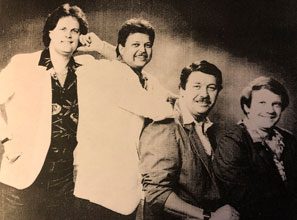 “By all rights, that morning should have been a newspaperman’s dream. There were fantastic stories of escape, including recounting of fear and elation. Any one of them would have made a first-page feature story in any newspaper. Yet I was defeated by the flood of experiences. I listened until the stories finally became merged, overlapping and paralleling and contradicting, until the whole adventure became a composite, and today it is in my mind as in theirs a sort of generalized blur.” – Ernie Pyle, Here Is Your War (New York, Henry Holt, 1943)
“By all rights, that morning should have been a newspaperman’s dream. There were fantastic stories of escape, including recounting of fear and elation. Any one of them would have made a first-page feature story in any newspaper. Yet I was defeated by the flood of experiences. I listened until the stories finally became merged, overlapping and paralleling and contradicting, until the whole adventure became a composite, and today it is in my mind as in theirs a sort of generalized blur.” – Ernie Pyle, Here Is Your War (New York, Henry Holt, 1943)
Ernie Pyle was one of America’s premier journalists during World War II. He wrote these words while embedded with GI’s in Tunesia, getting shot at, sleeping on the ground, and eating canned rations along with our soldiers. Aside from being granted access to almost everyone he sought out, from privates to generals, he sweated the same German air strikes, gagged on the same grit, and slogged around in the same soggy gear smoking the same cigarettes. Families back home hung on his every word. He was their eyes and ears on the war.
Back then America had about 1,750 daily newspapers. In 1950, the daily paper paid circulation was 124% of households. Today (per 2016) we have about 1,290 papers, a 26% drop since the war. Running frantically against this tide we have nearly countless cable, internet and social media news sources. We are all but drowning to death in news outlets. This includes me. My daily news feeds include the New York Times, Wall Street Journal, Washington Post, LA Times, The Week, Time, Atlantic magazine, The New Yorker, Fox News, Politico, The Hill, Bloomberg, NBC, ABC, CBS, Reuters, Huffington Post, NPR, and CNN. There I am, one more guy swimming upstream in a tsunami of straight news stories, opinion pieces, and downright baloney.
There’s an old saying that “misery loves miserable company.” A friend of mine recently wrote to me, “Interesting that you mention the media. I was listening to a podcast during 4 days in the car traveling to and from Arkansas. One of the comments was that one of the big differences between the Trump impeachment and the Nixon impeachment is the right wing media, especially Fox Noise. The commentator (Michael Isikoff) said that when Nixon was impeached there was no Fox Noise and Bill Barr lying about the obstruction and cover-ups. So the vast majority of Americans and congressmen supported impeachment and Nixon had to go.
Now you have Barr and Fox telling people that Trump has fully cooperated and was exonerated and people believe it. People like the lady at Republican congressman Justin Amash’s town hall meeting who had no idea that the Mueller report actually stated that the Russians interfered with the election and Trump did everything he could to stymie the investigation. When people just listen to partisan lying the truth doesn’t come out. And it that has a huge effect on what is left of democracy.” Relevant facts don’t offer us much comfort here. Despite this deluge of news and related ‘information,’ Americans seem to be as ignorant and poorly informed as ever, maybe more so. For example, despite a supposedly booming economy, many Americans seem oblivious to the fact that after adjusting for inflation, American workers’ average wages have not increased in 41 years. Yes, back when Jimmy Carter was president. Remember cape collared long dresses? How about corduroy overalls? OK last chance: Star Wars family pajamas?
I don’t hear this wage stagnation being mentioned at MAGA rallies. Yes, unemployment rates are remarkably low, but how many workers are earning minimum wage or just plain underemployed? Could they afford even those cheesy pajamas? And the dire threat of global climate change including the many millions of people it will displace? (Hello immigration hard liners). How is that playing at those raucous rallies?
Then we have this little armor piercing shell. Despite all the hubbub over quashing illegal immigration into the U.S. and the horrid conditions at overcrowded border detention facilities, most Americans (61%) can’t pass the U.S. citizenship test. This according to a recent report by The Woodrow Wilson National Fellowship Foundation. Only 13 percent of people surveyed knew the Constitution was ratified in 1788; most respondents think it was 1776, when the Declaration of Independence was signed. Too picky you say? Here’s one for Mr. Pyle: 60% did not know which countries America fought during WWII. How about this one: 57% did not know there are nine justices are on the Supreme Court.
According to Woodrow Wilson Foundation President Arthur Levine, these findings are “embarrassing” and [show] that it is important to be informed, especially in the face of upcoming elections. I’ll put it more bluntly: how the bleep do we run a democracy with so many blithering idiots marching to the polls? I’m not advocating literacy tests but how about some screening for cognizance of basic facts? We don’t need to get too tricky, either. But here are a few maybes. Doyou know that religious attendance is down in America (41% of those polled said they attended religious services once a week or more in 2000; today it’s 29%). Do you know anything about job apprentice programs in this country? OK, sports fans, what about the 103 year old woman stills runs competitive 50-yard dashes? How good our women’s soccer team is? Your Congressman’s name? Mayor? When your next election is?
Still on my soapbox: this critique is widely reflected in media reports. Time, for example, reports that “Unfortunately, many Americans lack fundamental civics knowledge, according to the recent Constitution Day Civics Surveyby the Annenberg Public Policy Center of the University of Pennsylvania, and therefore cannot understand current events.” There are some real stunners here. For instance, only 26% of Americans can accurately name all three branches of government; a third of respondents could not name a single branch, 27% knew only one branch. So about three quarters of Americans are ignorant about our basic government structure. Yeah, right, trick questions. Sure.
Where to turn. My recommendations, while perhaps a tad simplistic, revolve around a few simple suggestions for all of us.
- 1) Look for generic come-on headlines in your e-mails like “Jack we’re desperate; Conservatives blast… Liberals hammer… Ditch Mitch” and delete in 1% or less of the time it took you to read this.
- 2) Get off social media entirely. OK, at least come down gradually: ‘yep, only 4 hours on Facebook today, three hours tomorrow…’Bribe yourself with a kale, hummus and organic bamboo shoot smoothie. With a bacon cheeseburger.
- 3) Pick a good daily newspaper and read it every day, for two weeks.Then pick a different one for two weeks. No other papers until the fifth week and we check your vital signs.
- 4) Swap an hour or more of “news time” with guru approved outdoor activities.Don’t bring your phone unless it’s to call 911 or the guru.
- 5) Ask your friends to engage in witty conversations with you about the most interesting news article and the most disturbing.
- 6) No more one issue voters with one issue brains. (Prepare for a cranial MRI.)
And finally, find something to smile about in the news. Something just funny, or heartwarming, or reaffirming. Think about what you’d like to tell the next person who asks you, “So what’s new?”








